Folding Dough Over and Over Again Callwd
Bulk fermentation (also called the outset rise or primary fermentation) is one of the most important steps of yeast staff of life baking. Information technology begins right when mixing ends and lasts until the dough is divided and preshaped. The name signifies exactly what it is: the step when the dough is fermenting in a large, single mass.
During this time, fermentation creates organic acids and carbon dioxide gases, each of which plays an important office in dough development. Organic acids are primarily what give the dough season and forcefulness (acids assistance condition the gluten network) and carbon dioxide gives the dough book and lightness.
While our friendly yeast and bacteria are doing most of this piece of work, the dough still benefits from a periodic check-in by the baker. We help regulate dough temperature and strength through a series of folds, and these check-ins also give us an opportunity to appraise how the dough is progressing.
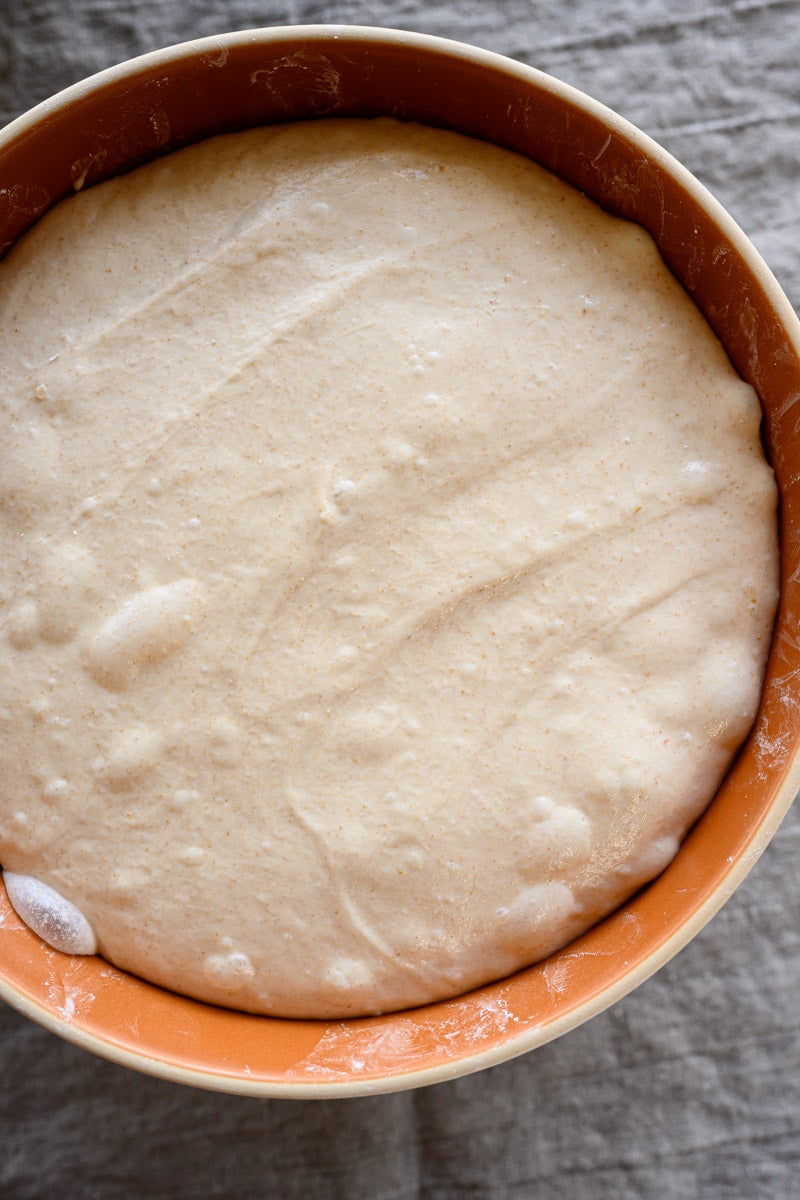
For a typical sourdough bread recipe, I let majority fermentation play out at room temperature over iii to v hours. But this fourth dimension menstruum is ultimately dictated by the staff of life you're making, what the recorded desired dough temperature is, and the temperature at which you lot proceed the dough.
In this mail service, we'll examine a few things to look for in determining when to end majority fermentation; but offset, permit's await at why we fold staff of life dough during bulk fermentation.
Why stretch and fold?
Folding helps add force to bread dough through a very simple series of actions: stretch the dough out and over itself. This act of stretching and folding, which takes simply a few moments, helps develop the gluten network in the dough. Each fold has a meaning touch on dough strength.
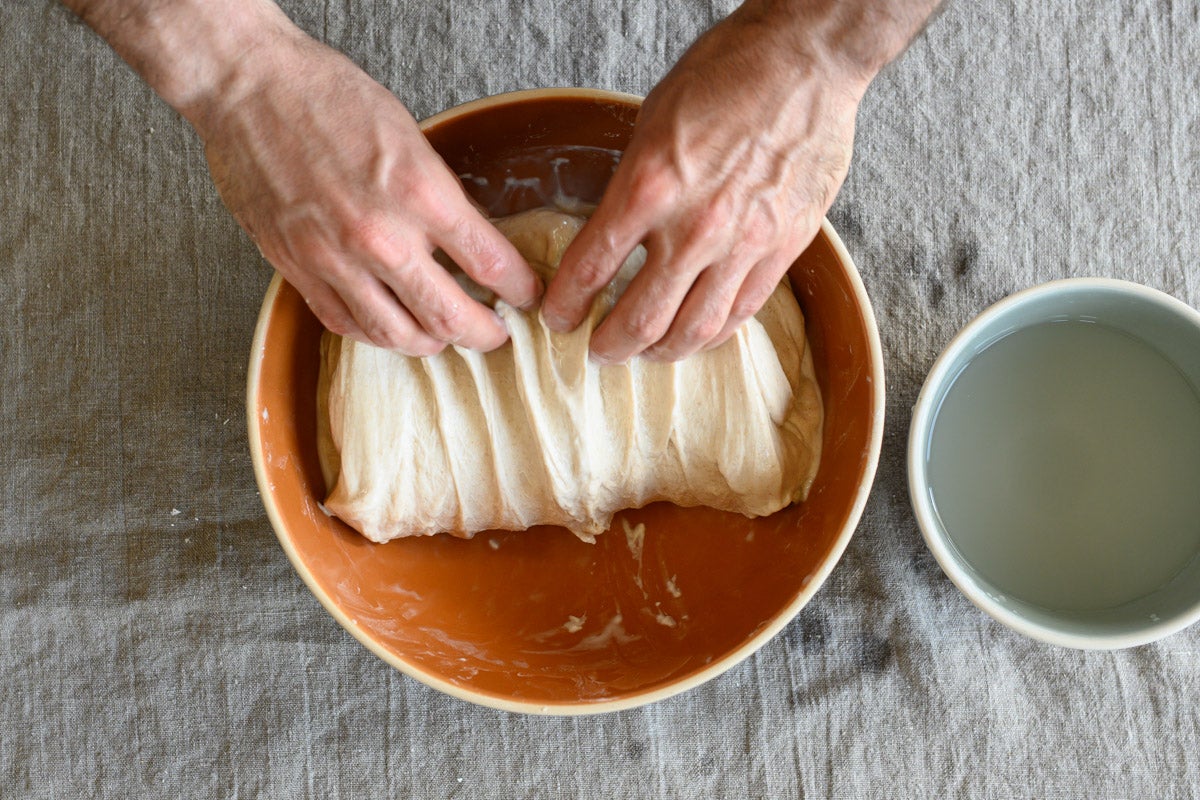 Through folding, nosotros're also helping to regulate dough temperature throughout the unabridged bulk mass. This ensures the dough'due south temperature is relatively even throughout — no cool or warm spots at the superlative or bottom.
Through folding, nosotros're also helping to regulate dough temperature throughout the unabridged bulk mass. This ensures the dough'due south temperature is relatively even throughout — no cool or warm spots at the superlative or bottom.
And finally, at each set, nosotros take a gamble to handle the dough and gain a firsthand cess on how information technology'southward developing: is the dough sluggish because it's absurd in the kitchen? This means nosotros might need to extend majority fermentation. Is information technology stiff enough for preshaping or does it need another set of folds? Past interacting with the dough in this way, we accept an opportunity to answer these questions and adjust class as necessary.
When should I stretch and fold?
This process works best when you perform a quick series of folds and and then let the dough residue. In the left-hand image below, yous can see the dough bunched tightly in the center later performing a set up of stretches and folds. In the right prototype, you can come across information technology relaxed after a 30-infinitesimal rest, fix for some other gear up of folds.
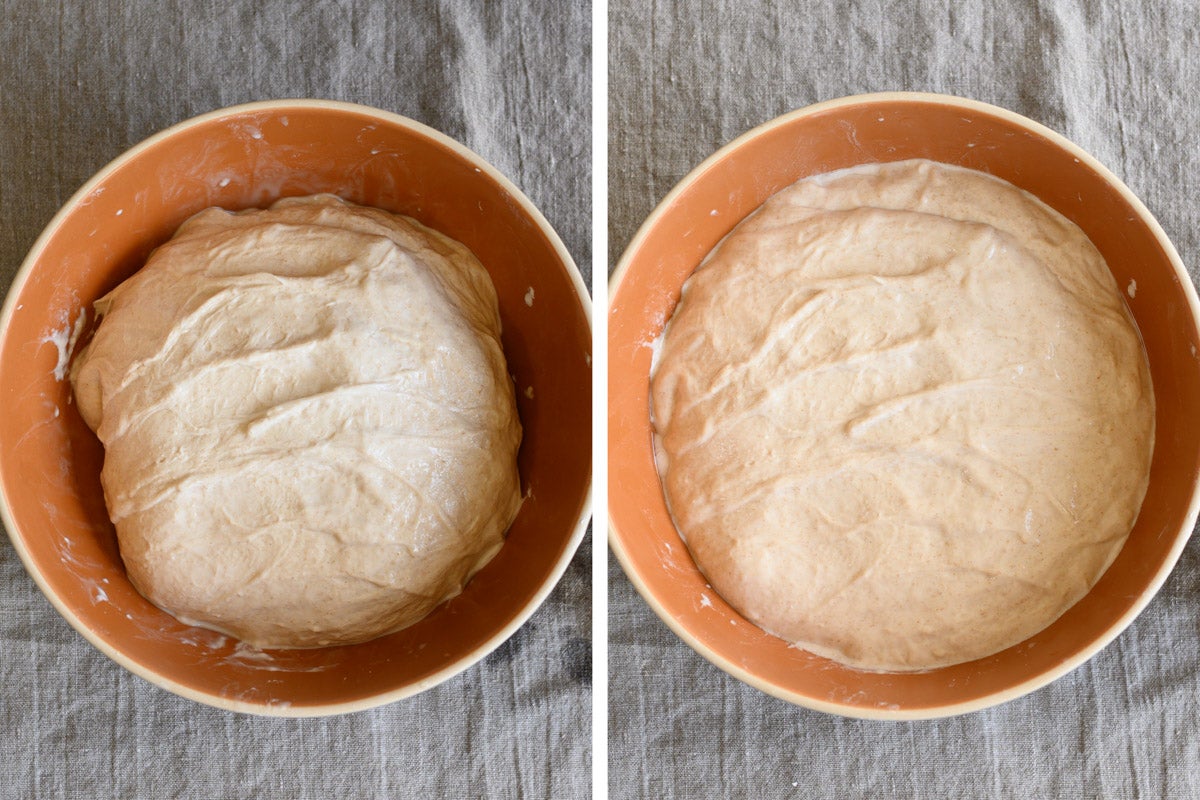
If you lot try to perform another set likewise soon, you'll find the dough is too tight. Information technology'll be hard to stretch and may even tear. For most doughs, I detect spacing out each set past 30 minutes (with the showtime prepare happening thirty minutes after the beginning of bulk fermentation) to be just correct.
How to fold bread dough
At that place are many ways to fold breadstuff dough, but my preference is to perform them directly in the bowl. First, get a modest bowl filled with water and place it next to your bulk container. Dip your easily in the h2o before folding to prevent excessive sticking.
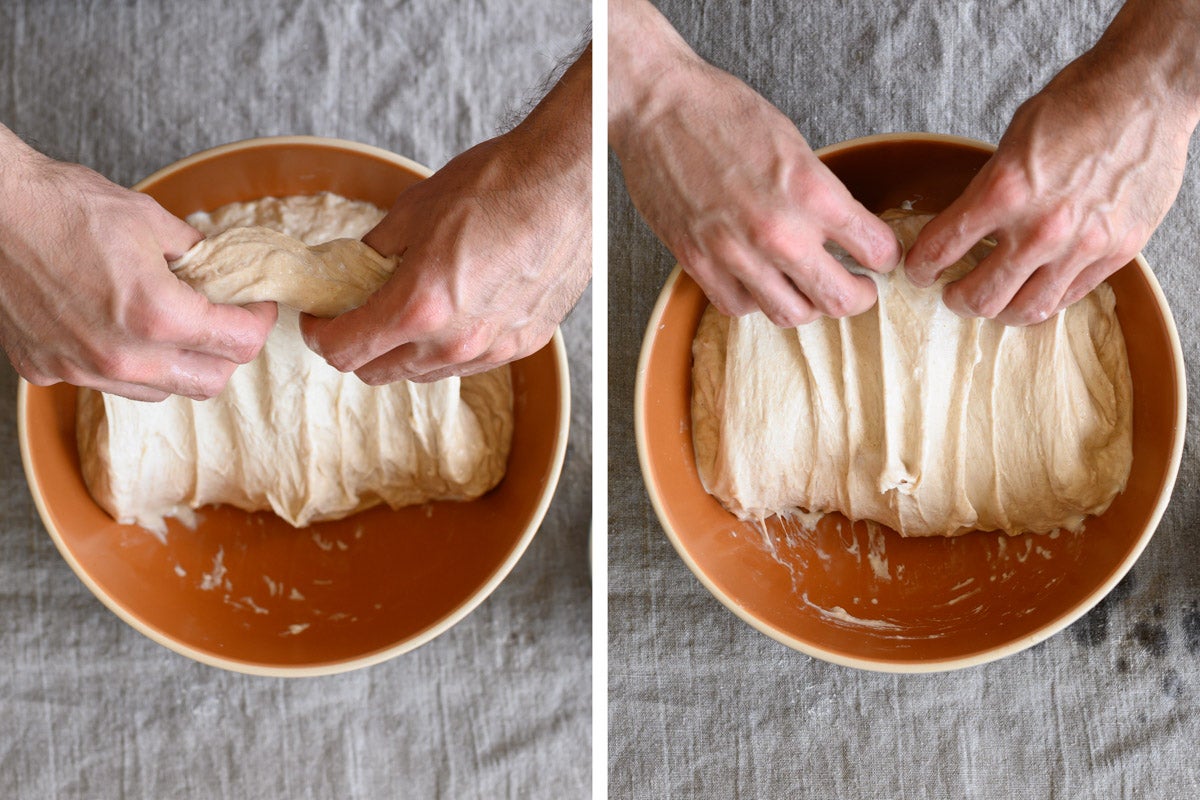
You will perform the same up-and-over motility four times, turning the basin later each fold. As shown above, use ii wet hands and grab the side of the dough farthest from you, then lift it up and over to the side nearest your body. Next, rotate your container 180°, wet your easily again if necessary, and perform the aforementioned stretch and fold. Adjacent, rotate your container ninety°. Grab the side of the dough uttermost from yous; once again stretch information technology upwardly and over to the side of the container nearest your body. Rotate your bowl 180° and perform the same fold 1 final time.
To finish the gear up, I like to gently pick the dough upward in the center and let the ends fold under but a little. This helps keep the dough tidy in the middle.
Watch this video to see the full stretch-and-fold process:
How many sets of folds are needed?
There's no single answer for how many sets your dough needs. If you lot hand-mix your dough, two to four sets should do it. Of form, the type of flour and hydration in a recipe also play a big part in answering this question. By and large, the slacker the dough, the more folds we'll need to sufficiently strengthen it.
After I perform a gear up of stretches and folds, I like to make a judgment call: was the dough difficult to stretch out and fold over? If then, I likely tin omit future sets of folding and let the dough rest for the balance of bulk fermentation. Was the dough withal slack and extensible? If then, I might do another set and reassess afterwards.
Also, there are many doughs for which folding might non be necessary. For example, with a 100% rye staff of life, you can probable skip folding because the gluten backdrop in rye don't strengthen the aforementioned mode that wheat gluten does. Additionally, if your dough is very stiff and low hydration — or if it was mixed and kneaded to total development before bulk fermentation — in that location's no demand to impart boosted force through folding.
When to end bulk fermentation?
Finding the exact point when to terminate bulk fermentation takes exercise. With fourth dimension, you'll learn to read the signs of sufficient fermentation: dough strength, elasticity, smoothness, book proceeds, and bubbly advent.
But making this call can be difficult. Cut bulk fermentation short might mean your dough won't be sufficiently fermented and you lot'll caput toward an nether-proofed upshot. On the other hand, if you button bulk fermentation also far, your dough volition be difficult to handle and on the verge of over-proofing. In that location's a balance to be found.
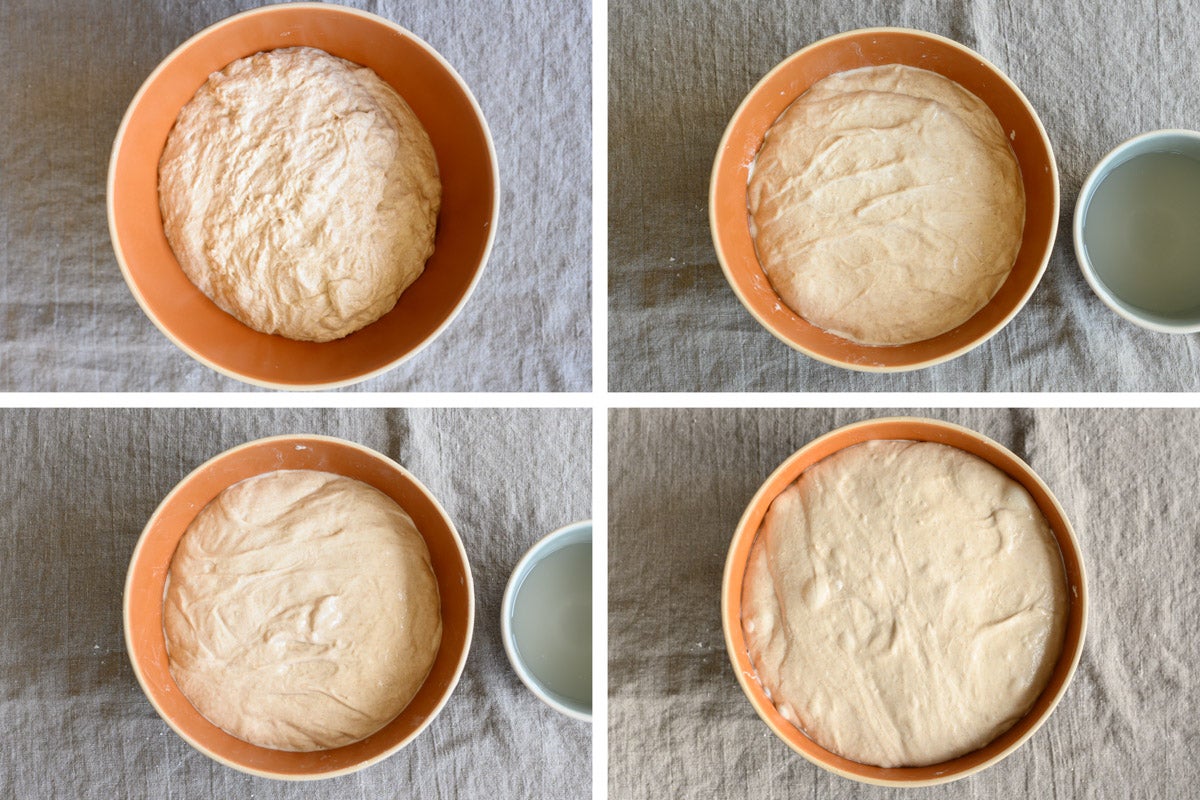
In the prototype above, see how information technology initially starts as a shaggy mass, but eventually rises significantly and becomes smooth, strong, and bubbly?
At the cease of majority fermentation, I await for a dough that's risen significantly and is much smoother than when bulk started. If you tug on the dough a little with a moisture hand, you'll feel resistance and elasticity.
Additionally, await for liveliness. Gently shake the bowl and it'll jiggle, letting you know there's plenty of aeration in the dough. These are all great signs that the dough has fermented sufficiently and is strong enough to be divided.
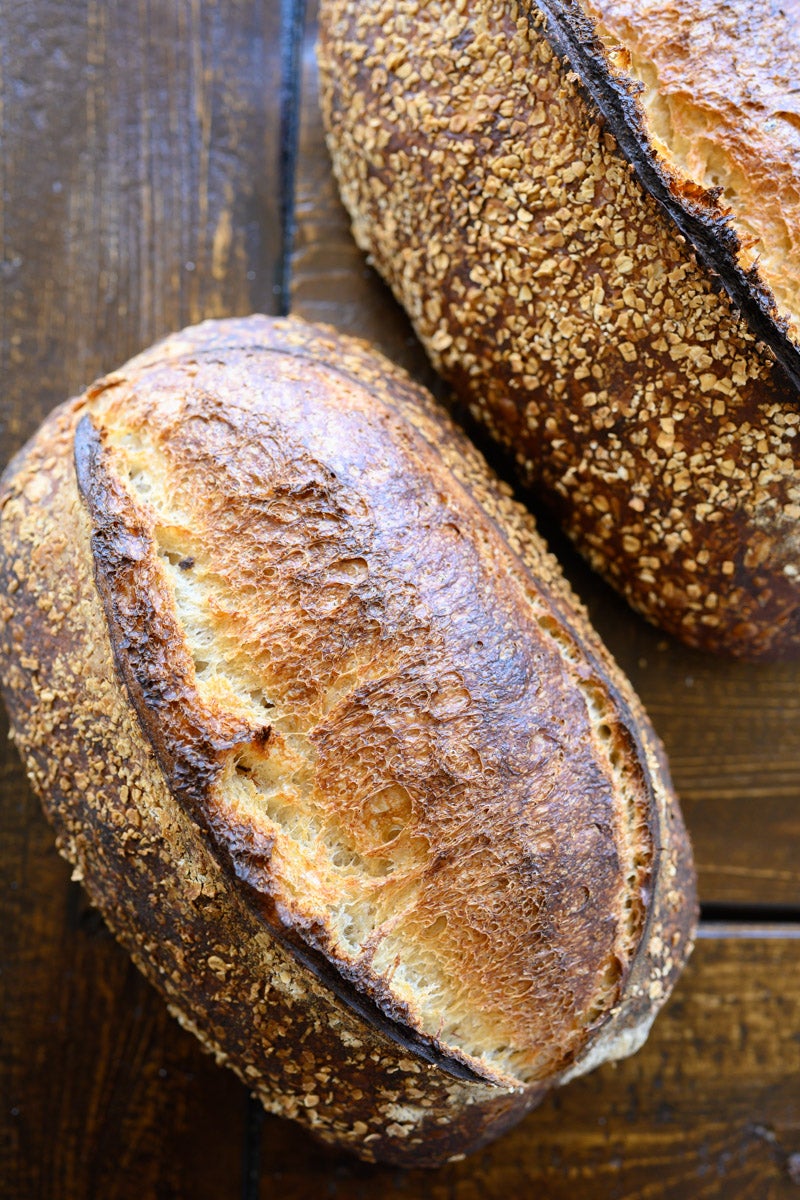
Strong fermentation, sufficient dough strength, catastrophe bulk fermentation at the right time, and a full proof – these are all steps required for a wonderful loaf of staff of life. And equally you develop a sense for how to execute on each of these, you lot'll gustation the difference in every bite.
For more information on all steps of the bread-baking process, including a different method for folding bread dough in bulk fermentation, visit the Rex Arthur Flour Consummate Guide to Sourdough Blistering.
Source: https://www.kingarthurbaking.com/blog/2019/07/22/bread-dough-bulk-fermentation
0 Response to "Folding Dough Over and Over Again Callwd"
Post a Comment